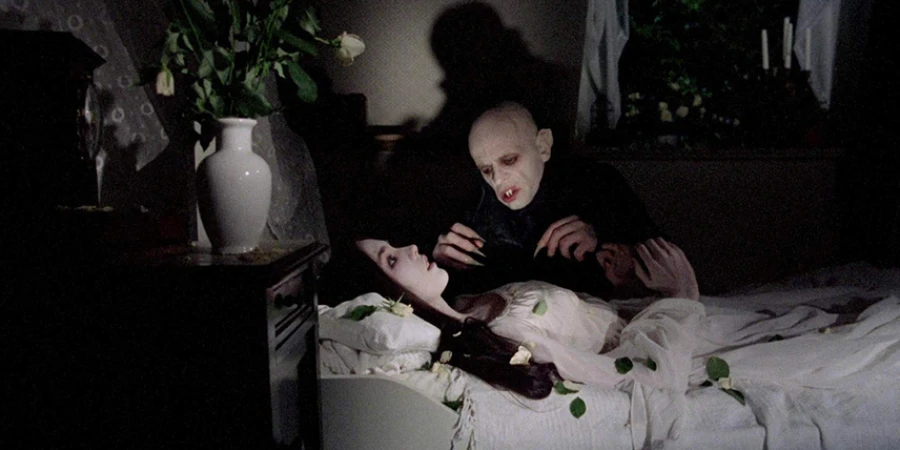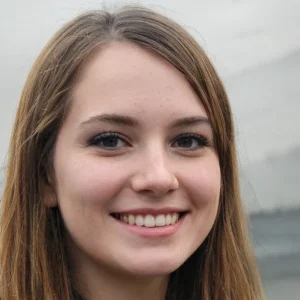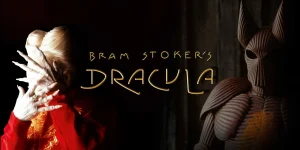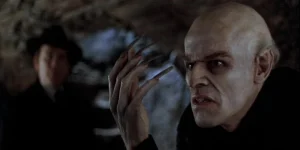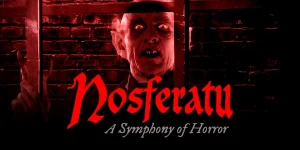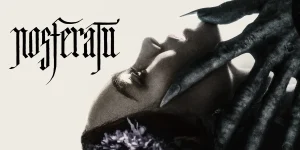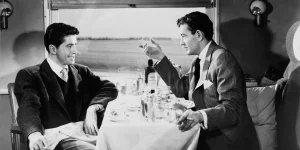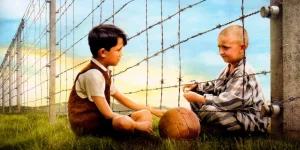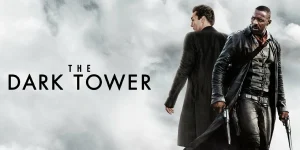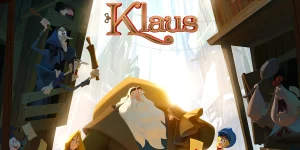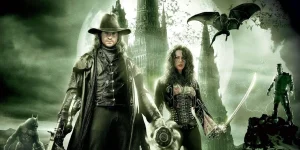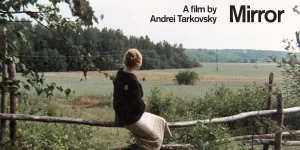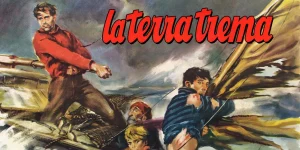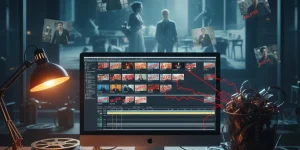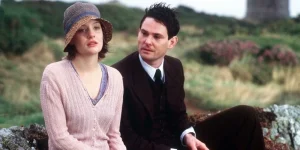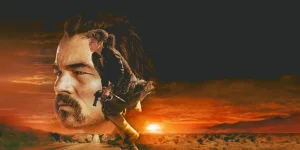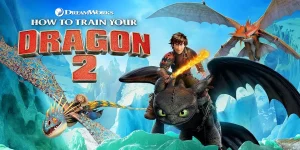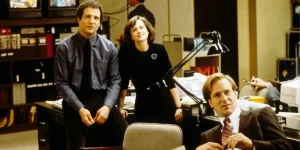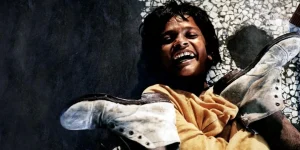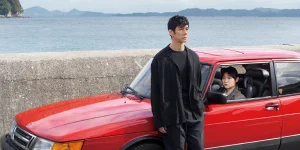Werner Herzog’s Nosferatu the Vampyre (original German title: Nosferatu: Phantom der Nacht) is not simply a remake of F.W. Murnau’s 1922 silent classic—it’s a somber, atmospheric reimagining drenched in existential dread and romantic melancholy. Released in 1979, Herzog’s film pays homage to its source material while embedding his unique philosophical outlook and visual poetry.
Table of Contents
ToggleDetailed Summary
The Journey to Transylvania
Jonathan Harker (Bruno Ganz), a young estate agent in Wismar, Germany, is sent by his employer Renfield (Roland Topor) to Transylvania to arrange a real estate transaction with the elusive Count Dracula (Klaus Kinski). Despite ominous warnings from locals, Harker makes the arduous trip, encountering increasingly disturbing signs: desolate villages, eerie howls, and whispered superstitions.
Once he reaches Dracula’s crumbling, shadow-drenched castle, he meets the Count—a pale, rat-like figure with elongated claws and dead eyes. Dracula is instantly captivated by a photo of Harker’s wife, Lucy (Isabelle Adjani), and signs the deal to purchase a house directly across from theirs in Wismar.
The Infection Begins
As Dracula feeds on Harker during his stay, Jonathan becomes increasingly weakened and mentally disoriented. Dracula departs by ship with coffins full of Transylvanian soil—and rats. Meanwhile, Lucy begins experiencing disturbing dreams and psychic connections to the Count. When the ship arrives in Wismar, its crew is dead, and rats swarm the city. A plague spreads, bringing death and despair.
Lucy’s Growing Horror
Lucy, the only one who seems to understand the truth of what’s happening, tries to warn the town, but no one believes her. Her husband, having escaped Dracula’s castle, arrives in Wismar, but is physically and emotionally broken—barely able to function. Renfield descends into madness, laughing hysterically and babbling about his “master.”
Dracula Moves In
Now living across from Lucy and Jonathan, Count Dracula spreads his disease in both literal and metaphoric form. Lucy, desperate and courageous, researches vampire lore and discovers that Dracula can only be destroyed by a pure-hearted woman who willingly offers herself to him and keeps him feeding until sunrise.
Movie Ending
In the film’s haunting climax, Lucy confronts Count Dracula and lures him into her room. She seduces him, and he feeds on her throughout the night, intoxicated by her beauty and sacrifice. As dawn breaks, Dracula collapses and dies, his body fading away in a moment of poetic stillness. Lucy, having knowingly given her life to destroy him, dies moments later—heroic, tragic, and peaceful.
But the horror is not truly over.
Jonathan Harker, who had been slowly transforming during the film, now reveals his metamorphosis. He has become the new vampire. Donning a dark cloak and whispering cryptic declarations, he rides off into the distance, now a creature of the night—cold, calculated, and ready to begin his reign.
This final twist reframes the entire film as a cycle: Dracula is dead, but the curse lives on.
Are There Post-Credits Scenes?
No, Nosferatu the Vampyre does not feature any post-credits scenes. The film ends with Harker’s transformation and departure, leaving viewers with an unsettling sense of continuation beyond the frame—a classic Herzog move.
Type of Movie
Nosferatu the Vampyre is a Gothic horror film with elements of art-house cinema, existential drama, and romantic tragedy. It straddles the line between supernatural horror and philosophical reflection.
Cast
- Klaus Kinski as Count Dracula
- Isabelle Adjani as Lucy Harker
- Bruno Ganz as Jonathan Harker
- Roland Topor as Renfield
- Walter Ladengast as Dr. Van Helsing
Film Music and Composer
The eerie, ethereal soundtrack is composed by Popol Vuh, a German progressive/electronic band frequently used in Herzog’s films. Their blend of ambient music, organ tones, and choral arrangements lends the film a spiritual, otherworldly texture that enhances its haunting imagery.
Filming Locations
- Wismar, Germany – The primary town setting. A real medieval city that provides historical authenticity.
- Delft, Netherlands – Used for some city scenes due to its preserved Gothic architecture.
- South Tyrol (Italy/Austria border) – Used for mountain and landscape shots.
- Czech Republic and Slovakia – Additional Transylvanian-like backdrops.
These locations are vital in creating a timeless, placeless atmosphere. The towns look old enough to be believable as 19th-century Europe, but isolated enough to feel mythic and surreal.
Awards and Nominations
While the film didn’t dominate major awards circuits, it has received long-term critical acclaim and is often cited in “Best Horror Films of All Time” lists. It won a Silver Bear for Outstanding Single Achievement at the 1979 Berlin International Film Festival and received several European film festival honors.
Behind the Scenes Insights
- Herzog reportedly had to direct Klaus Kinski with extreme patience; their infamous working relationship involved shouting matches, threats, and brilliant collaboration.
- Isabelle Adjani insisted on a level of artistic control over her character, infusing Lucy with a tragic romanticism beyond the script.
- The rats used in the film (thousands of them) were dyed grey for aesthetic purposes—a controversial production choice, especially for animal rights activists.
- Herzog directed both a German-language version and an English-language version to appeal to international audiences—filming each scene twice.
Inspirations and References
- F.W. Murnau’s Nosferatu (1922) – The film is a direct remake/homage to this silent German Expressionist film.
- Bram Stoker’s Dracula – While Nosferatu originally evaded copyright by renaming characters, Herzog’s version leans back into the source novel’s themes.
- The work of Caspar David Friedrich, especially in its foggy landscapes and lonely figures, deeply influenced the film’s visual style.
Alternate Endings and Deleted Scenes
There are no known alternate endings. However, the dual-language shoot (English and German) resulted in slightly different performances. Some deleted material included extended dialogue between Lucy and Van Helsing, which slowed the pacing and was ultimately removed.
Book Adaptations and Differences
While Herzog’s film isn’t based directly on Bram Stoker’s Dracula, it mirrors its plot more closely than Murnau’s 1922 version. The largest difference lies in tone: Herzog’s Dracula is not a seductive aristocrat but a suffering, lonely creature, almost more to be pitied than feared. The ending twist with Jonathan Harker becoming the new vampire is Herzog’s own addition—absent in both previous versions and the original novel.
Memorable Scenes and Quotes
Key Scenes
- Jonathan’s dinner with Dracula, where the Count stares obsessively at Lucy’s portrait.
- The ghost ship arriving in Wismar—no crew, only rats and silence.
- Lucy walking through the plague-stricken town as people dance and die around her.
- Dracula’s final death as the sun rises, his body fading into dust.
Iconic Quotes
- Dracula: “Time is an abyss… profound as a thousand nights.”
- Lucy: “He is not the Devil. He is a poor soul, lost in a world he cannot escape.”
- Jonathan: “I have seen the abyss, and it looked back at me.”
Easter Eggs and Hidden Details
- The mirror scene echoes Murnau’s iconic framing, with Herzog adding a sinister twist: Dracula’s reflection appears briefly, only to vanish.
- Lucy’s name is Lucy Harker, a fusion of Stoker’s Lucy Westenra and Mina Harker, streamlining two characters into one.
- Renfield’s deranged laughter and obsession with insects are directly lifted from the 1922 and 1931 Dracula films, yet more grotesque here.
Trivia
- Klaus Kinski’s Dracula makeup took over 4 hours to apply each day.
- Werner Herzog financed much of the film himself, believing in its artistic importance.
- The rats had to be imported and caused multiple delays during shooting due to animal control regulations.
- This was the first horror film many critics took seriously as art cinema since the 1960s.
Why Watch?
If you’re drawn to atmospheric, slow-burn horror that values mood over jump scares, Nosferatu the Vampyre is essential viewing. Herzog’s film is more about death, decay, and the soul’s loneliness than mere vampire lore. It’s equal parts beautiful and terrifying, a melancholic dream in celluloid form.
Director’s Other Movies
- Aguirre, the Wrath of God (1972)
- Fitzcarraldo (1982)
- Stroszek (1977)
- Grizzly Man (2005)
- The Enigma of Kaspar Hauser (1974)
Recommended Films for Fans
- Nosferatu (1922)
- Nosferatu (2024)
- Dracula (1979)
- Let the Right One In (2008)
- The Witch (2015)
- Shadow of the Vampire (2000)
- The Hunger (1983)

